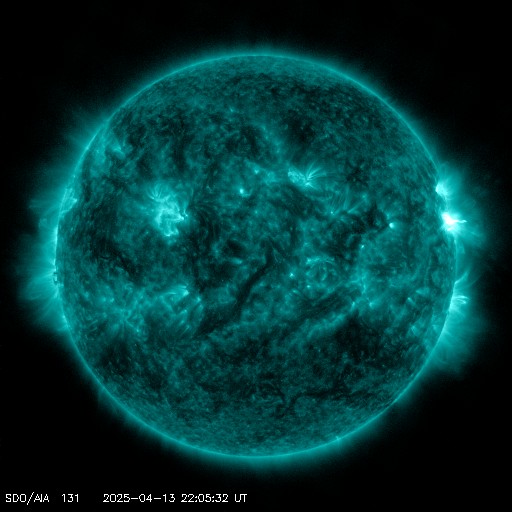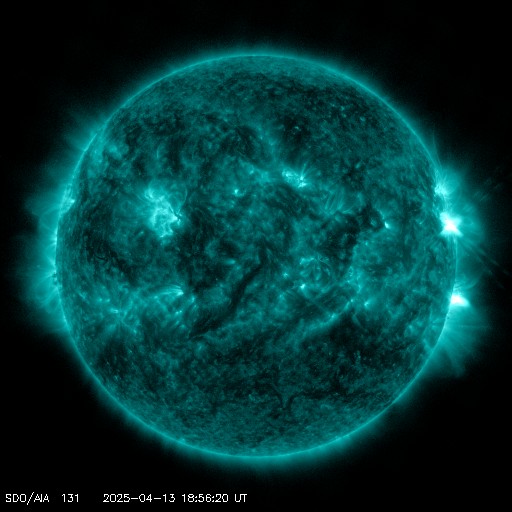Het archief bekijken van zaterdag 16 november 2024
Dagelijks bulletin over zonne- en geomagnetische activiteit van het SIDC
Datum verslag: 2024 Nov 16 1231 UTC
SIDC Prognose
Zonnevlammen
M-class flares expected (probability >=50%)
Geomagnetisme
Quiet (A<20 and K<4)
Proton Flux monitor
Quiet
| 10cm flux | Ap | |
|---|---|---|
| 16 Nov 2024 | 150 | 011 |
| 17 Nov 2024 | 150 | 010 |
| 18 Nov 2024 | 150 | 015 |
Zonnevlekkengebieden en zonnevlammen
Solar flaring activity was moderate over the past 24 hours, with two M-class flares identified. A total of four numbered sunspot groups were observed on the disk during this period, as SIDC Sunspot Group 283 (NOAA 3854/3886) rotated beyond the western limb, and no new sunspot groups were observed. The largest flare was an M1.6 flare (SIDC Flare 2614), peaking on November 16 at 01:37 UTC, produced by the most complex region, SIDC Sunspot Group 288 (NOAA Active Regions 3859, 3889), currently located at S09W43, which maintained a Beta-Gamma-Delta magnetic configuration over the past 24 hours. SIDC Sunspot Group 294 (NOAA Active Region 3893), currently located at S19E34, has a Beta magnetic configuration and produced the second M-class flare, SIDC Flare 2611, an M1.0 flare peaking on November 15 at 12:18 UTC. Solar flaring activity is expected to remain moderate over the next 24 hours, with C-class flares very likely and a chance for M-class flares from the two currently most active regions on the disk, SIDC Sunspot Groups 288 and 294.
Coronale massa uitstoten
A significant number of large filaments are currently facing Earth. So far, the filaments remain stable, and no Earth- directed coronal mass ejections (CMEs) have been detected in the available coronagraph imagery over the past 24 hours.
Coronale gaten
The recurrent SIDC Coronal Hole 68, which first reached the central meridian on 2024-11-07 (and initially on 2024-09-10), is now positioned on the western side of the Sun, and its high-speed streams are currently influencing solar wind conditions near Earth. SIDC Coronal Hole 78, an equatorial coronal hole with positive polarity, first reached the central meridian on 2024-11-14 and is now positioned on the eastern side of the Sun.
Zonnewind
Over the past 24 hours, solar wind conditions near Earth were influenced by the high-speed stream associated with the positive-polarity, mid-latitude northern coronal hole (SIDC Coronal Hole 68), which crossed the central meridian on 2024-11-07. The solar wind speed was slightly lower than yesterday, with values decreasing from 500 km/s to current levels around 410 km/s. The total interplanetary magnetic field remained elevated, ranging from 7 nT to 10 nT, and the southward component of the interplanetary magnetic field, Bz, was predominantly negative, fluctuating between -9 nT and 6 nT. Solar wind conditions are expected to remain under the influence of this high-speed stream over the next 24 hours. Conditions are then expected to gradually return to a slow solar wind regime. On November 18, high-speed streams associated with Coronal Hole 78, an equatorial coronal hole with positive polarity that first reached the central meridian on 2024-11-14 and is currently transitioning across the central meridian, may reach Earth and impact solar wind conditions.
Geomagnetisme
Geomagnetic conditions over the past 24 hours were active (NOAA Kp 4, K BEL 4) due to the ongoing influence of high-speed streams from the mid-latitude northern coronal hole (SIDC Coronal Hole 68). Geomagnetic activity is expected to remain quiet to unsettled, with possible active conditions over the next 24 hours, particularly if the southward component of the interplanetary magnetic field, Bz, remains negative for an extended period.
Proton flux niveaus
The greater than 10 MeV GOES proton flux remained below the 10 pfu threshold over the past 24 hours. It is expected to stay below this threshold level over the next 24 hours. Due to the enhanced solar and flaring activity, a slight chance of an increase cannot be fully excluded.
Elektronenfluxen in geostationaire baan
The greater than 2 MeV electron flux measured by GOES 16 was below the 1000 pfu threshold and is expected to remain so in the upcoming days. The 24h electron fluence was at nominal level and is expected to remain so in the next days.
Het geschatte internationale zonnevlekkengetal (ISN) van vandaag: 076, gebaseerd op 05 stations.Zon indexen voor 15 Nov 2024
| Wolfgetal Catania | 098 |
| 10cm zonneflux | 149 |
| AK Chambon La Forêt | 020 |
| AK Wingst | 014 |
| Geschatte Ap | 015 |
| Geschat internationaal zonnevlekkengetal | 075 - Gebaseerd op 12 stations |
Overzicht opvallende gebeurtenissen
| Dag | Start | Max | Einde | Locatie | Sterkte | OP | 10cm | Catania/NOAA | Soorten radio-uitbarstingen |
|---|---|---|---|---|---|---|---|---|---|
| 15 | 1205 | 1218 | 1226 | S20E43 | M1.0 | SF | 97/3893 | ||
| 16 | 0126 | 0137 | 0141 | S10W39 | M1.6 | 1N | 93/3889 |
Aangeboden door het Solar Influences Data Analysis Center© - SIDC - Verwerkt door SpaceWeatherLive
Alle tijden in UTC
<< Keer terug naar de dagelijkse overview pagina
Op basis van de huidige parameters is er in de nabije toekomst een beperkte kans op poollicht op de volgende locaties van de hoge breedtegraad
TórshavnOulu, Rovaniemi
Reykjavik
Trondheim
Luleå
Laatste nieuws
Laatste forumberichten
Steun Poollicht.be!
Om ook bereikbaar te blijven bij grote poollichtkansen hebben we een zware server nodig die alle bezoekers aankan. Doneer en steun dit project zodat we online blijven en je geen enkele poollichtkans mist!

Laatste alerts
22:21 UTC - Zonnevlam
Matige M1.66 zonnevlam van zonnevlekkengebied 4055
22:03 UTC - Radio blackout
Kleine R1 radio blackout gedetecteerd (≥M1 - momenteel: M1.01)
20:48 UTC - Hemisferisch vermogen
Het OVATION-model voorspelt dat het hemisferisch vermogen 50GW zal bereiken om 21:39 UTC
19:09 UTC - Zonnevlam
Matige M3.24 zonnevlam van zonnevlekkengebied 4055
18:51 UTC - Radio blackout
Kleine R1 radio blackout gedetecteerd (≥M1 - momenteel: M1.07)
Ruimteweer feitjes
| Laatste X-klasse uitbarsting | 28/03/2025 | X1.1 |
| Laatste M-klasse uitbarsting | 13/04/2025 | M3.1 |
| Laatste geomagnetische storm | 06/04/2025 | Kp5 (G1) |
| Zonnevlekkenloze dagen | |
|---|---|
| Laatste zonnevlekkenloze dag | 08/06/2022 |
| Maandelijks gemiddeld zonnevlekkengetal | |
|---|---|
| maart 2025 | 134.2 -20.4 |
| april 2025 | 136.4 +2.2 |
| Afgelopen 30 dagen | 134.2 -8.9 |




